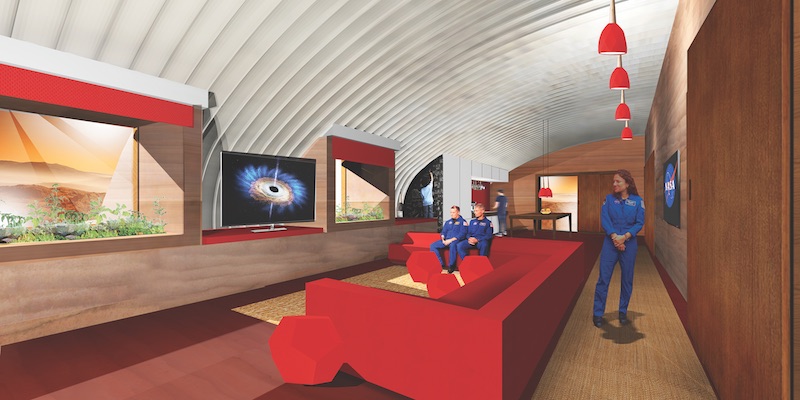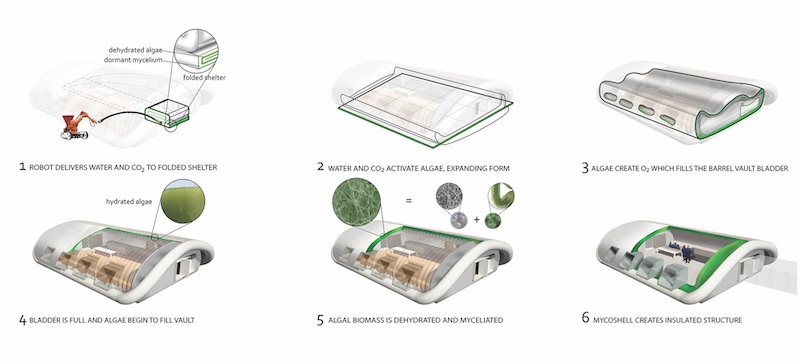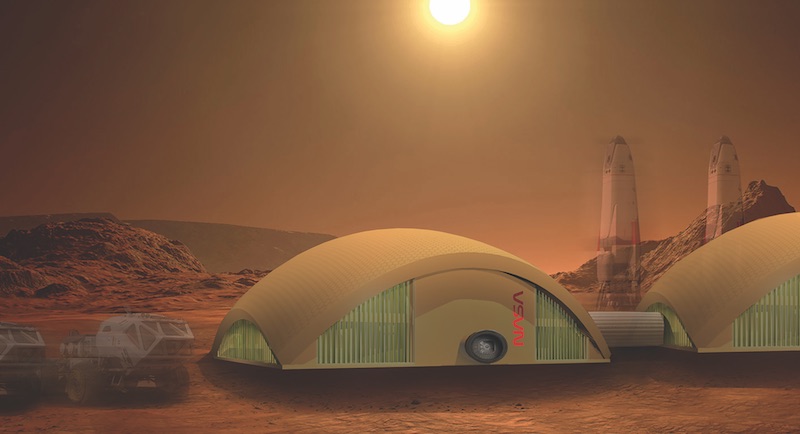The thought of colonizing Mars has science fiction aficionados, scientists, and billionaire entrepreneurs staring up at the night sky with renewed wonder and inspiration. But the key to achieving the lofty goal of colonizing and building extensively on a new planet may not exist out among the stars, but under our feet right here on Earth.
Christopher Maurer, an architect and Founder of Cleveland-based Redhouse Studio, and Lynn Rothschild, a NASA Ames researcher, believe algae and mycelium (the vegetative part of a fungus that consists of a network of fine white filaments) may make the perfect building material on Mars.
See Also: Rovers set to invade construction jobsites
The algae, which would act as the food supply for the fungus, and mycelium spores would be packed into a flexible plastic shell where it would be watered and coaxed to grow, providing structure for the shell and filling it out almost like air fills out a bouncy castle.
 Courtesy Redhouse Studio.
Courtesy Redhouse Studio.
Here is how Rothschild, the principal investigator on the project, and Maurer, the co-investigator, envision the process working on Mars:
• Hermetically sealed bags containing dehydrated algae and dormant mycelium would be delivered to Mars (at a fraction of the weight, space, and cost of traditional building materials) and deposited at a given build site. The bags would then be unfolded and laid flat.
• A rover would deliver carbon dioxide, nitrogen, and water sourced from Mars to begin the growing process. The double-sealed plastic shell will fill with air and water, and the embedded algae will begin to grow. This reaction will create oxygen and biomass to fill the shell and give it form.
• Fungi are released and bind with the dried algal biomass to create a strong composite. This packed mycelium has a compression strength that is better than that of lumber and a better bend strength than reinforced concrete. The entire process would only take a couple of
days to complete.
 Courtesy Redhouse Studio.
Courtesy Redhouse Studio.
Essentially, astronauts would have a sustainable building material that can be altered to produce anything from more fabric-like materials to the ultra-compacted, rigid material required for structural uses. There is also the possibility that it can be bioengineered with pigments to protect against one of the toughest obstacles associated with building on Mars: radiation. The shells could be made in any shape to produce dwellings reminiscent of the ones we are more acclimated with here on Earth.
This project, which is being funded by the NASA Innovative Advanced Concepts program, is nowhere near becoming a reality, but it is one of the most well-rounded ideas yet for building on another planet.
Related Stories
| Sep 13, 2010
Community college police, parking structure targets LEED Platinum
The San Diego Community College District's $1.555 billion construction program continues with groundbreaking for a 6,000-sf police substation and an 828-space, four-story parking structure at San Diego Miramar College.
| Sep 13, 2010
Second Time Around
A Building Team preserves the historic facade of a Broadway theater en route to creating the first green playhouse on the Great White Way.
| Sep 13, 2010
Triple-LEED for Engineering Firm's HQ
With more than 250 LEED projects in the works, Enermodal Engineering is Canada's most prolific green building consulting firm. In 2007, with the firm outgrowing its home office in Kitchener, Ont., the decision was made go all out with a new green building. The goal: triple Platinum for New Construction, Commercial Interiors, and Existing Buildings: O&M.
| Aug 11, 2010
New data shows low construction prices may soon be coming to an end
New federal data released recently shows sharp increases in the prices of key construction materials like diesel, copper and brass mill shapes likely foreshadow future increases in construction costs, the Associated General Contractors of America said. The new November producer price index (PPI) report from the Bureau of Labor Statistics provide the strongest indication yet that construction prices are heading up, the association noted.










